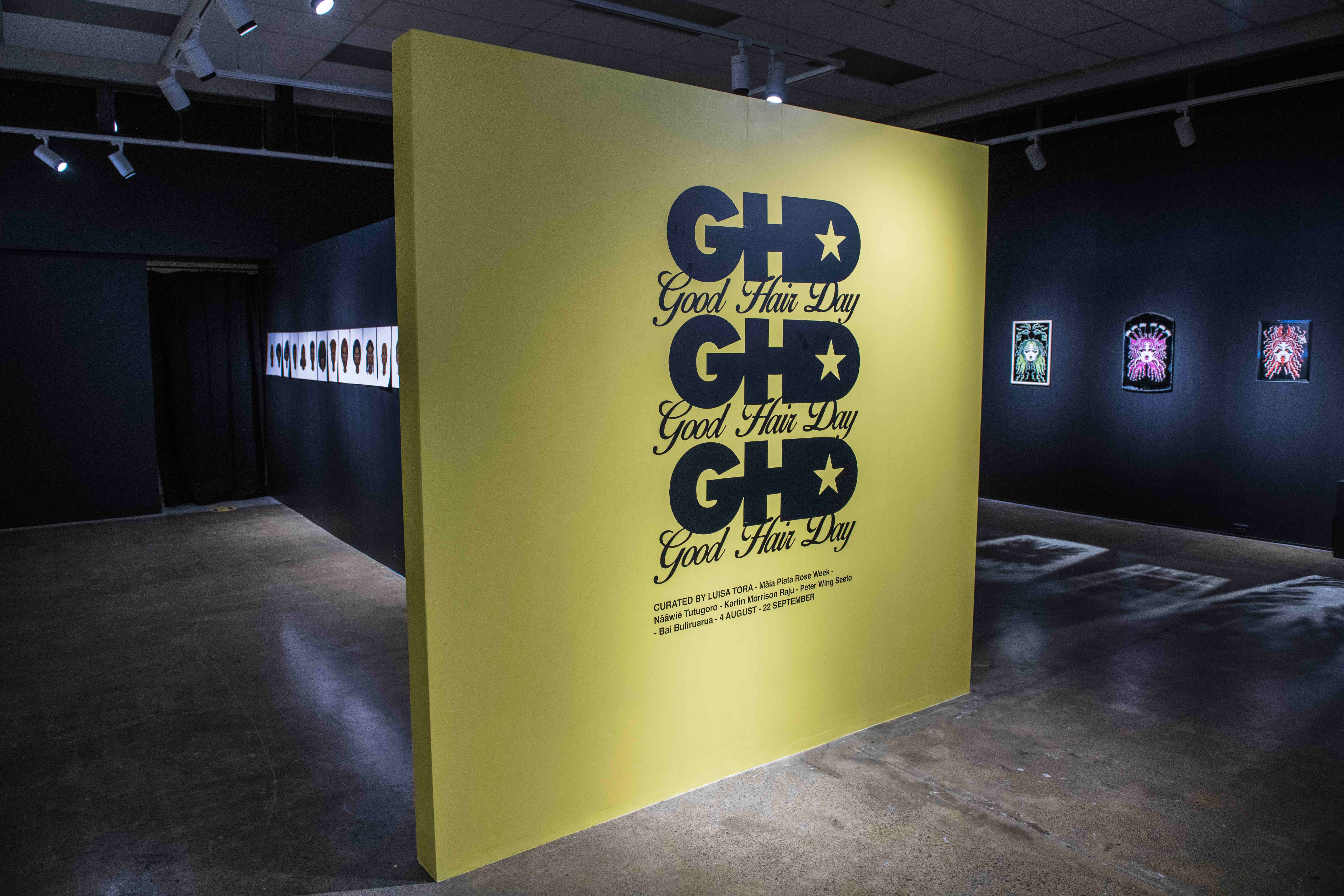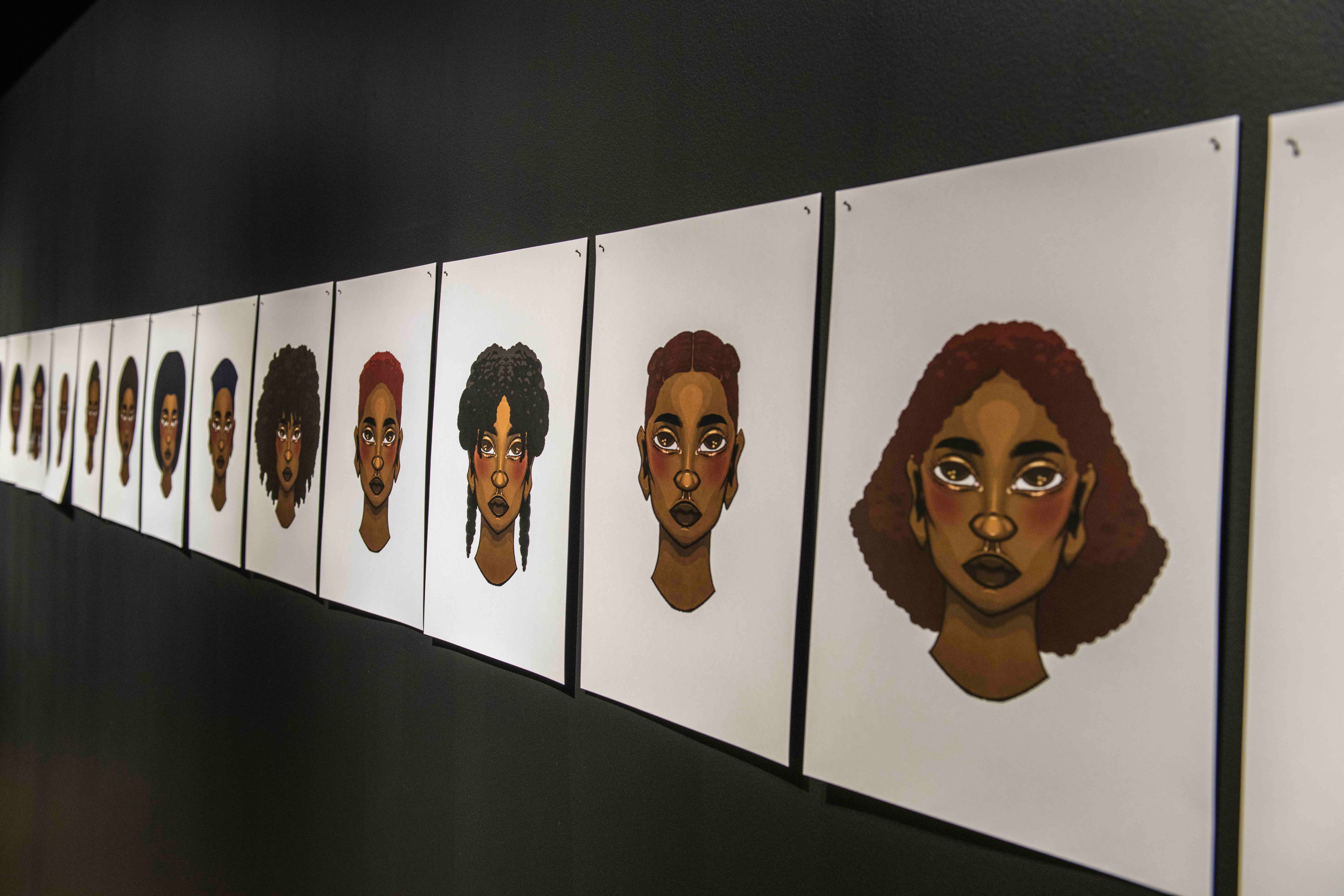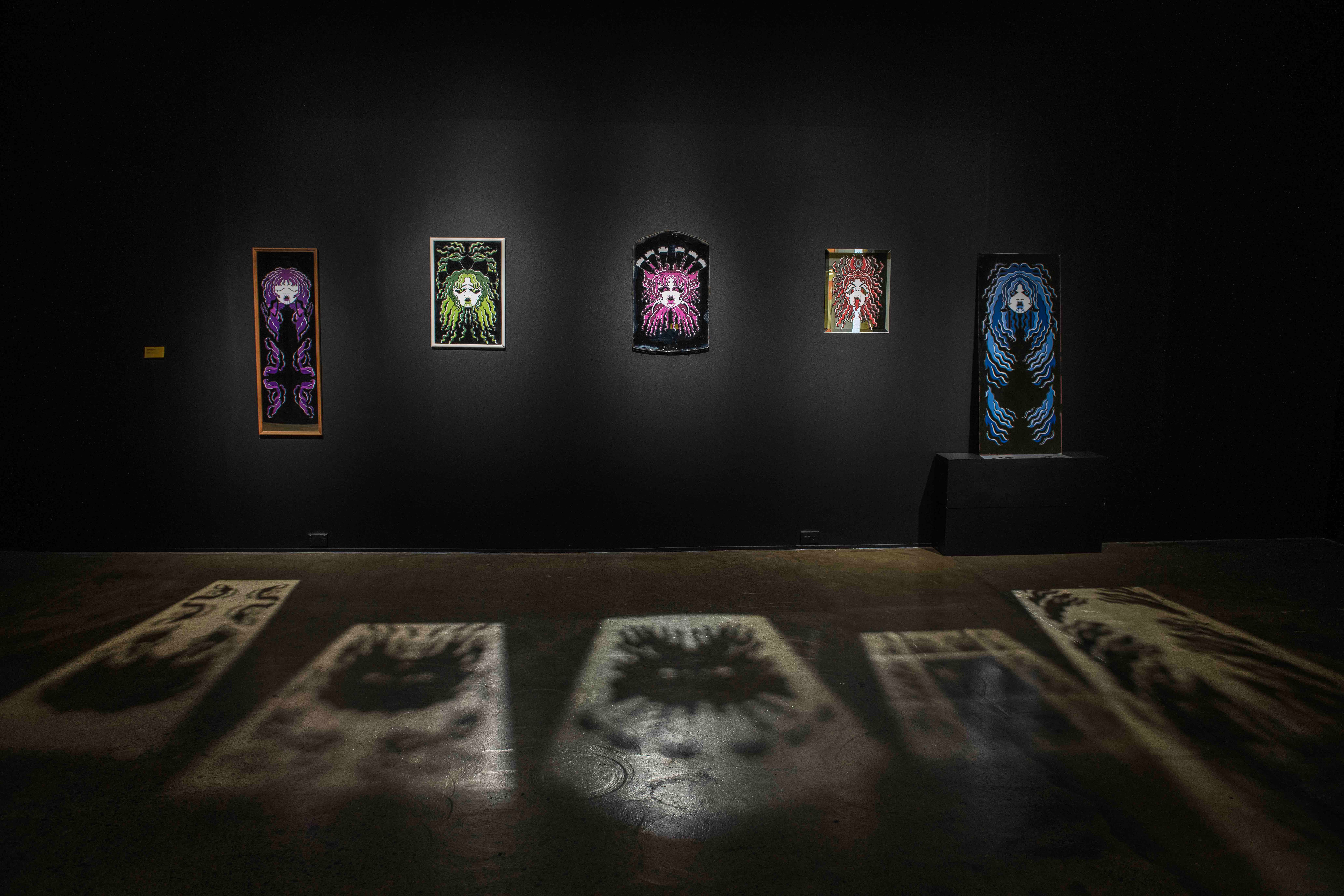Archives of Joy and Hair Revolution
Kitty Wasasala explores the interlinked threads across Moana hair in urban and diaspora spaces, in Good Hair Day at Tautai Pacific Arts Trust, Tāmaki Makaurau.
My eldest sister, Jahra, had the hair I always wanted – the beautiful Fijian curl, tamed into submission with our mother’s Pākehā sensibility, falling down their back like water. Jahra, the ever-cool winner of the genetic lottery, in a way only your older siblings ever really are. So when GHD hair straighteners entered the scene, they only became cooler to me. “Pink GHDs were the thing because, back then, we were all bringing our straighteners to school – not just young girls, it was the boys [too],” Jahra reflects, laughing. “And if it wasn’t your straightener, it was your sister’s straightener, so the boys would bring, like, their sisters’ straighteners to school. It was the fucking thing.”
But there are no archives of this – none of the 2006 drop of the hot-pink GHDs. None of the smell of burning hair in classrooms, sizzling like whispers. None of the half-ripped Girlfriend and Creme magazines scattered across our bedroom floors, the cover girls nowhere as cool as us but bestowing their hair-styling tips upon us anyway. None of the Cool Charm and hairspray mingling in the changing rooms, a nauseatingly sweet bubblegum cloud following you to English. Other archives, the academic ones in dark libraries and long halls, tell different tales of Māori and Pacific Islanders from our time here – leeches, overstayers, dole bludgers – stories of pain, always pain, and always force-fed to us by white hands. Our languages were butchered, our hair tamed, our names shortened, and yet our inherent, bone-deep joy remained intact, however low it had to lie to survive. There are no archives of our joy, however frivolous or trivial it may have seemed to onlookers.
Our inherent, bone-deep joy remained intact, however low it had to lie to survive.
I know the joy well, though. I feel it ripple through my sister through the phone, even now as they recall how owning a GHD was “the highest clout you could possibly imagine. It was a status symbol. It was ‘you’re in’. It was pop culture. It was everything.” All of this is to say – you can say what you want about brown kids using GHD hair straighteners as proximity to whiteness and, sure, there’s an element of truth in that – but that doesn’t take away from the magic of a shared ritual, the whimsy of a new tool and the joy we found in developing personal relationships with our hair. This includes the sharing of knowledge and resources that helped us to cultivate and understand community – because a brown girl in community is powerful, and that brown girl having a Good Hair Day is unstoppable.
Kitty Wasasala: I think it’s because it’s called Good Hair Day that I was able to reflect so quickly that there wasn’t the pain that I was expecting to experience. It was a good hair day. I’m so used to hearing stories of the diaspora, of the pain, and it’s like, nah, actually, it wasn’t that. I mean, there’s inherent struggle, right? And it’s always going to be part of it, but nah, I just felt totally celebrated and light and I was wondering if that was a conscious choice as a curator.
Their audio is glitchy and unforgiving, but they agree – it’s tempting to indulge the pain when it’s all we’ve been given. Feeding it is forgivable when it has produced some of our best mahi. It makes the suffering bearable and worth it, until it doesn’t. “We can’t always think that ‘everyone’s got it out for me’ and that sort of thing, because if you do that, then you continue to carry the fallacy of their work in your work,” curator of the show, Luisa Tora explains. “And that is not what you want, but that tends to happen.”
Peter Wing Seeto hair blong me 1, 2, and 3 installation view, 2023. Image by Raymond Sagapolutele.
Pushing through pain and embracing warmth, nostalgia and joy in our mahi toi is easier said than done, but don’t our audiences, as well as our artists, deserve it? Hasn’t pride and celebration always been our greatest and most fruitful defiance? I’m reminded of this in Peter Wing Seeto’s offering, Hair blong mi – their hair, vibrant embroidered thread in all its crowning glory, pouring then lifting out of the stretched canvas, defying form, defying gravity, begging to be seen and demanding to be celebrated.
However, the onus can’t be entirely on the artist – responsibility lies also with the galleries, the curators and the commissioning bodies to push our artists, particularly our rangatahi, to explore other avenues in their work; they can’t do so if they aren’t properly guided and supported. Thankfully, Luisa’s practice as a curator allowed the artists to keep their work evolving up until the last minute.
hair, vibrant embroidered thread in all its crowning glory, pouring then lifting out of the stretched canvas, defying form
Luisa Tora: I think that they were quite generous with their stories and how they’d come to the work that they’d made. Initially, Bai was going to do decal of that intimate moment where he's cutting his mother's hair. She just decided that, of all his siblings, he'd be the one to cut her hair. But at the last minute, he changed his mind and did a more ethnographic work in a contemporary setting, which worked out equally beautiful. There were quite a few iterations for the artists, and we just rolled with it. We were like, “We can do it,” and Tautai was totally accommodating that way. They were really gracious hosts and very patient, and so we were able to accommodate that. I think that they came to the right decisions in the end, as you can see in the show, at least I think so. And I’m a bit biased [laughs]. Just a little bit.
Bai Buliruarua, For My Mama and Anyone Who Look Like Her installation view, 2023. Image by Raymond Sagapolutele.
So Bai Buliruarua’s for my mama and anyone that look like her came to be, blessing the space with its digital portraits. Near-identical portraits line the wall, the subjects staring straight ahead, expressionless but not cold. Their only differences are their hairstyles, with each style transforming the subject from ‘90s video girl to Polynesian Panther and beyond. Buliruarua’s work highlights the shapeshifting power of Pacific Island wāhine and gender minorities in a world of strict binaries, offering the perspective of hair as both armour and accessory. Warm, stoic, dreamy, commanding – the woman, the being, has limitless potential.
Good Hair Day itself is a response to the late Pacific academic and activist Dr Teresia Teaiwa’s call to “build our own archives” to ensure future generations have access to our perspectives and our stories, told by us. “[Teaiwa] was researching Fijian women in the British Army and she didn’t find an archive like her peers [did],” Luisa tells me. “She had to build her own, and she talks about building your own.”
Nââwié Tutugoro dream come true installation view, 2023. Image by Raymond Sagapolutele. (IMG 0229 and 0259).
Nââwié Tutugoro’s dream come true maps out a metaphysical archive of its own, using the artist’s blue-dipped hair to emulate the journey across space and time, across father and daughter, across known and unknown. This piece was activated live in the gallery, with Tutugoro recreating the journey, moving from one wall to another with a low whistle and a dream-like daze. Their painted hair streaked against the pitch-black gallery wall, wildly and wistfully blue, acting as the vessel through which their story could be told and their archive built.
I destroyed my own archives long ago, in the form of Facebook photos, Tumblr posts, Twitter profiles. How I wish I hadn’t now. O, what I would give to hold hands with my younger self; to brush her hair, to turn it to rope and wrap it around her, to trust her to never let it go. But that never happened – instead I unravelled. In the process of becoming an actor, I lost all identity. I used thick, electric-blue hair gel to control my hair on screen. I let my hair out, bouncing wildly, when I wanted to convey lunacy. Being desperate to homogenise and earn my place meant abandoning my sense of self, my quirks, my differences, my whakapapa, my archives.
Māia Piata Rose Week, Hair Mask installation view, 2023. Image by Raymond Sagapolutele.
Māia Piata Rose Week’s Hair Mask, vinyl masks adorning mirrors, struck me like no other. Like modern-day Lindauer portraits, the masks are full of distinction and mana. They vary in colour and are bold and bright, with hair flowing freely. Standing in the mirrors allowed me to see myself the way Maia might see herself – poised, powerful, vulnerable, capable. I could have spent hours with each mirror, speaking to the god within each realm, reciting their archives aloud. I imagine all of their mokopuna and muses to come, the storytellers that will emerge from these archives.
Jahra, as the eldest sibling, has perhaps unknowingly taken on the storyteller role in our whānau, collecting threads from our father and making the language their own. They’re all grown up – they got rid of their GHD “maybe, like, seven years ago” and have become everything since. I watch them grow, stretch, bleed and celebrate their new skin at every shedding, but only ever from a distance. If you know Jahra, you’ll understand when I say that when they build on their own archive, not only does my whānau grow, but the arts industry in Aotearoa does, too. And I’m a bit biased.
I imagine all of their mokopuna and muses to come, the storytellers that will emerge from these archives.
Karlin Morrison Raju’s corrugated sits in a separate room, in a spotlight, in a well, in the pit of my stomach. A water barrel, tall and narrow, re-imagined and corrugated, filled with black; an empty coconut shell; two slabs of red and black concrete like a welcome mat. I can barely face it – all of the rituals I’ve never learned, every nerve in my scalp craving my ancestors’ guidance. In my dreams I meet them by the river, lined with stones like these. I wash my hair with them, and I don’t need to be told how. I would usually wake myself up if the river ran this black, but I can’t, I’m awake, so I look. The overhead light blocks the reflection but I recognise my silhouette straight away by the shape of my hair. The water isn’t black. I’m safe. I imagine the stupid jokes my brother would make in this room and how my sisters would tell us off. I’m here again.
I wash my hair with them, and I don’t need to be told how.
Luisa knows the importance of this work, and they don’t take this responsibility lightly. The curation process, something I can only imagine takes so much sensitivity and skill, must be heightened when you consider the social and cultural implications of creating archives. Luisa finds their strength in continuing to push for their artists’ voices to be heard.
LT: I’d love to keep that vibe going and keep the word out. Before you know it, it will [have been] the 23rd of September [the closing of the show] eight months ago. It’s something I’d like to see continue, so that this is not just a show that happened and nothing else was heard of it. I would love to see this show travel – maybe to Pōneke, and anywhere else that would have us. I think that it’s a beautiful show, and it has an important conversation from a young generation. I’d like to see [these archives] join the broader art conversation. And hopefully that will be reflected in our public programming.
When I off-handedly asked Luisa what music they would send someone into the exhibition with, not knowing there had already been a stunning mix made, they said they didn’t recall what was played on the exhibition’s opening night.
LT: Honestly, there was so much talking going on…
KW: Just the sound of the aunties laughing? That’s my favourite song.
LT: That’s right. Aunties sitting in the corner, laughing and pointing at people.
Overpowering joy, defiant joy – an archive all on its own.






